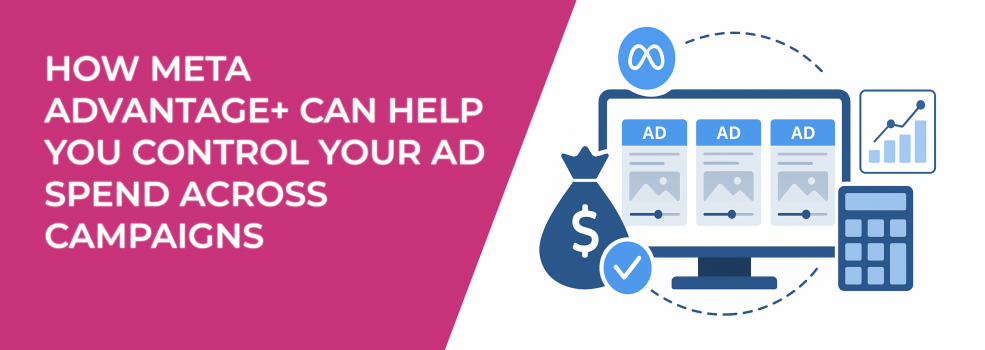If you’re managing Facebook or Instagram ad campaigns in 2025, you’ve probably felt the tension between automation and control. Meta Advantage+ promises better performance through automation, but the question remains: can you actually control your spend across multiple campaigns?
The answer is yes—but only if you understand how each Advantage+ feature works and where you can intervene to steer results in your favor.
This article breaks down the main Advantage+ tools advertisers should know, and offers practical strategies to stay in control while leveraging automation to scale.
Advantage+ Campaign Budget: Smarter Spending with Boundaries
Advantage+ Campaign Budget, previously known as Campaign Budget Optimization (CBO), lets you set a single daily or lifetime budget at the campaign level. Meta then automatically allocates that budget across ad sets based on which ones are expected to drive the best results.
This dynamic allocation can help maximize efficiency, but it can also backfire if one ad set ends up consuming the bulk of the budget while others get ignored.
To stay in control:
-
Set ad set spend limits. Use minimums to ensure specific audience tests get enough delivery, and use maximums to prevent broader or less-tested segments from eating up the entire budget.
-
Check performance early and often. After launching a campaign, review the ad set breakdown daily for the first few days. If you see skewed budget allocation without solid performance justification, make adjustments.
This tool is great for simplifying budget management, especially when you’re testing multiple audiences or creative angles, but only if you keep an eye on where your money is going.
To go deeper into campaign budget strategies, this guide on optimizing Advantage Campaign Budget offers step-by-step tactics for balancing automation with control.
Advantage+ Sales Campaigns: Performance at Scale, If You Segment Smartly
Advantage+ Sales Campaigns (formerly Advantage+ Shopping) are a powerful option for e-commerce businesses. Meta uses machine learning to automate targeting, creative combinations, bidding, and placements, essentially creating hundreds of ad variations from your inputs and delivering them to people most likely to purchase.
The results can be impressive, but the trade-off is a loss of granularity. You can’t manually select interests or behaviors. You can’t break down results by detailed audiences within the campaign. And that’s where smart campaign structuring becomes essential.
To keep control:
-
Segment by product category, geography, or business objective. If you sell both premium and budget products, create separate Advantage+ Sales campaigns for each. This keeps Meta from allocating spend disproportionately toward one category.
-
Exclude irrelevant or low-performing markets. Meta won’t automatically stop spending in locations with poor returns. Review geographic performance regularly and exclude regions that underdeliver.
By using multiple campaigns for distinct business priorities, you allow automation to work but on your terms. If you’re selling online, here’s a full breakdown of how to get the most out of Advantage+ Sales Campaigns for e-commerce success.
Advantage+ App Campaigns: Flexible, But Monitor Closely
Advantage+ App Campaigns are designed for mobile app advertisers and help automate delivery across installs, in-app actions, or value-based events. You provide creative, your app’s app store link, and select a goal. Meta handles the rest, optimizing budget and placements to reach users most likely to convert.
However, automation doesn’t mean you’re locked out of making important decisions.
Advantage+ App Campaign budget can be divided between installs and in-app purchases depending on what's your priority.
To stay in control:
-
Segment campaigns by platform or geography. If your app performs differently on Android vs. iOS or in different regions, create separate campaigns so you can set tailored budgets and monitor performance more effectively.
-
Monitor in-app metrics closely. Installs alone can be misleading. Look deeper into in-app events and return on ad spend, especially if you're optimizing for value.
App campaigns benefit greatly from scale, but they also depend on clean data and a clear feedback loop. Make sure your tracking infrastructure is solid before relying fully on automation.
For app marketers, this detailed walkthrough on using Advantage+ App Campaigns explains how to scale installs without losing control of quality.
Advantage+ Leads Campaigns: Simplified Lead Gen, But Requires Precision
Advantage+ Leads Campaigns are built for businesses that use Facebook lead forms. Meta automates audience selection, placements, and budget allocation to get you the most leads at the lowest cost.
But lead quantity doesn’t always equal quality. Broad targeting can attract users who aren’t actually interested or qualified.
To stay in control:
-
Use narrow custom audiences when lead quality matters. Upload your CRM segments or website visitors to create more targeted campaigns.
-
Test lead form structures. Meta will optimize delivery, but not form design. Short forms may boost volume, while longer forms can improve quality. Run A/B tests to find the right balance.
Automation here is most effective when paired with thoughtful audience input and a well-designed funnel behind the lead.
This article explores how to refine Meta Advantage+ Lead Campaigns to attract leads that convert, not just fill your CRM.
Advantage+ Targeting Features: Hidden Levers That Affect Spend
There are several targeting tools under the Advantage+ umbrella that directly influence how your budget is spent, often in ways that aren’t obvious at first glance.
Advantage+ Audience
This feature lets you upload a seed audience (like website visitors or past customers), and Meta will expand it automatically to find similar users. The platform prioritizes performance, even if that means reaching beyond your intended segment.
To maintain control:
-
Use high-quality seed audiences. The better your source data, the more relevant Meta’s expansion will be.
-
Monitor audience overlap. If you run multiple campaigns, avoid sending overlapping signals to the same users.
Advantage+ Detailed Targeting
For conversion-focused campaigns, Meta may automatically expand your interest or behavior-based targeting to find more people. This is often on by default, and you can’t exclude interests once it activates.
If precision matters (such as in B2B or niche verticals), you may want to disable this feature or test it against manually defined targeting.
Advantage+ Lookalikes
Meta uses machine learning to go beyond standard lookalike percentages, potentially expanding reach if your original audience is small. This can be powerful, but it can also dilute performance if not closely tracked.
Strategy tip: test standard 1%–2% lookalikes against Advantage+ Lookalike expansions to find the right balance between scale and relevance.
Curious about how Meta expands audiences in the background? Here’s a closer look at how Advantage+ Expansion works and how to steer it effectively.
Advantage+ Creative: Customization at Scale
This tool takes your assets—images, videos, primary text, headlines—and automatically generates different combinations for different users. It also adjusts creative size, format, and presentation based on placement and user behavior.
While this saves time, it also introduces risk: not every combination will reflect your brand voice or message accurately.
To stay in control:
-
Upload diverse, well-structured creative assets. Give Meta high-quality ingredients, and you’ll get better results.
-
Review performance by asset combination. Disable variations that underperform or misrepresent your offer.
Creative fatigue is real, even in an automated system. Refresh your content regularly to avoid performance dips.
Advantage+ Placements: Useful, But Needs Oversight
When using Advantage+ Placements, Meta distributes your ads across Facebook, Instagram, Messenger, and the Audience Network to get the best possible performance. While this can improve efficiency, not all placements are equal.
Some advertisers report higher engagement but lower conversion from Audience Network or Stories. These placements may inflate metrics like click-through rate without adding real value.
To stay in control:
-
Check placement-level data weekly. If certain placements are consistently underperforming, exclude them.
-
Adjust creative by placement type. A video that works in feed might not translate well to Reels or Stories.
Keeping a close eye on placement performance ensures you’re not wasting budget in channels that look good on paper but don’t drive actual results.
Final Takeaway: Strategy Still Matters
Meta Advantage+ isn’t fully hands-off. The best results come when you set clear goals, structure campaigns thoughtfully, and monitor performance regularly.
Run separate campaigns for different products or audiences, use spend limits where needed, and feed the system strong creative and audience signals.
Automation can scale your results, but only if you stay actively involved. Let Meta optimize, but keep your strategy in the driver’s seat.

